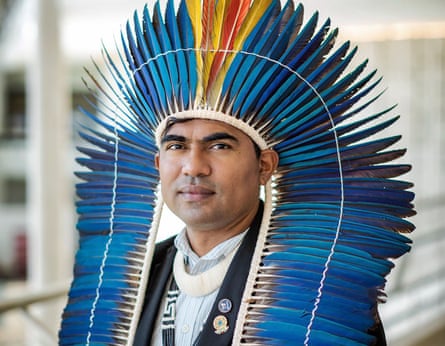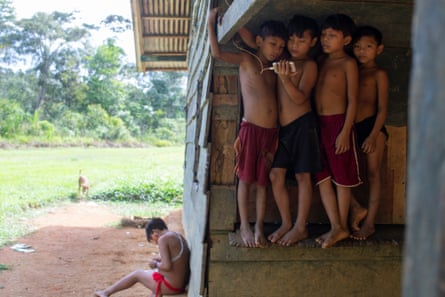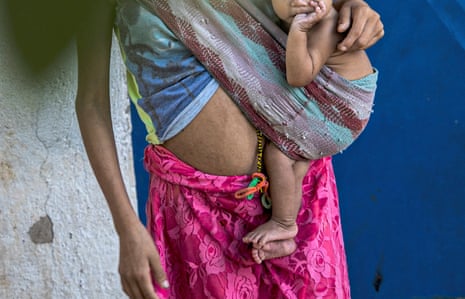The infant mortality rate among the Indigenous peoples of Brazil jumped by 16% last year, according to new data, as experts warn that the expansion of legal and illegal extractive industries in the Amazon rainforest has had profound effects on the health and quality of life of Indigenous people living in unprotected areas.
Over the past 50 years, the Amazon’s landscape has changed dramatically, with about 17% of the primary forest now gone, replaced by towns, roads, cattle ranches, mines and vast fields of soya beans.
But the Indigenous people who have inhabited the Amazon for millennia have benefited little from this development boom. Instead, these groups reflect the country’s lowest levels of social progress, particularly those who live outside protected territories.

“It is clear that Indigenous lands that are demarcated and protected by the state have greater self-sufficiency, greater health and sustainability for communities,” said Ricardo Weibe Tapeba, the secretary for Indigenous health in Brazil.
However, the failure of the state in recent years to recognise and oversee Indigenous territories has allowed invasions of loggers, illegal “wildcat” miners and drug gangs, as well as land speculation by agricultural and extractive businesses.
“The lack of state presence can lead to chaos and a health emergency, as we’ve recently seen,” said Tapeba.
Appointed after Luiz Inácio Lula da Silva took over Brazil’s presidency in January, Tapeba referred in particular to the crisis in the Yanomami territory, close to the borders of Venezuela. The community, in particular children, have been struggling with hunger and disease.
Data provided by the health ministry to the Guardian shows that the Yanomami health district has the worst Indigenous infant mortality in the country, at almost 80 deaths per 1,000 live births. This is more than seven times the Brazilian average, and 20 times the rate of England and Wales.
Infant mortality is a common indicator for assessing a country’s quality of life, according to the health ministry. In the case of the Indigenous areas, the rate is “also directly linked to [deficient] land management and external influences, such as illegal mining”, Tapeba said.
As in several Indigenous communities in the Amazon, large numbers of outsiders began entering the Yanomami’s land in the early 1970s, after Brazil’s military dictatorship opened roads through the region, driving environmental destruction and epidemics.
But the latest Yanomami crisis has been brewing since 2019, driven by the rising price of gold in international markets along with the dismantling of environmental enforcement under the government of the far-right former president Jair Bolsonaro.

The Indigenous groups in the Tapajós region, in the eastern Brazilian part of the Amazon, also face complex problems. Both legal and illegal mining are expanding in the area, and health authorities are struggling to deal with rising infectious disease, mercury contamination and children dying from preventable causes, according to the health ministry’s data and recent research. An aggravating factor is the pending demarcation of various Indigenous territories.
Alessandra Korap is an Indigenous leader of the Munduruku people from Sawré Muybu, an undemarcated territory in the Tapajós. The legal recognition of their land, which had been halted for seven years, moved one step closer in April. “The demarcation is critical for us,” said Korap, who hopes that this will help curb the predatory activities of outsiders and improve the health of her people.

Korap got the news when she was preparing to receive this year’s Goldman Environmental prize in New York. The award acknowledged her efforts for more than a decade in battling against mining activities in Sawré Muybu.
The Sawré Muybu is a 178,000-hectare (440,000-acre) rainforest in Itaituba, the region with the largest mining area in Brazil, according to Mapbiomas, which monitors land use. However, the activity has brought little progress to Itaituba, which ranks low in the Amazon’s social and environmental health.
“We must question if the last 70 years of mining exploitation are really making the Tapajós richer,” said Caetano Scannavino, co-founder of Projeto Saúde e Alegria (Health and Happiness Project).
His organisation helped supply clean water to Sawré Muybu and other riverside and Indigenous villages in the Tapajós basin. Scannavino said waterborne diseases were common in these communities – and the main cause of children’s deaths.
after newsletter promotion
Indigenous infant mortality has historically been higher than Brazil’s overall rate. Preliminary data by the health ministry pointed to 31 deaths of Indigenous children for every 1,000 live births across Brazil in 2022, a 16% increase on the previous year and the highest since 2010. This is the same rate for the Tapajós health district, and similar to African countries such as Malawi and Rwanda.
The health ministry said acute diarrhoea has been affecting Indigenous people for many years, indicating the territories’ low levels of health and development. Among 34 Indigenous health districts, the Tapajós has the third-worst levels of diarrhoeal disease, behind only the Yanomami and the Solimões regions, in northern Brazil close to the borders of Peru.
“In the third millennium, losing a child for something as silly as diarrhoea – something that could have been prevented – can’t be accepted, can’t be normalised,” said Scannavino.

Along with environmental destruction, malaria has also risen around the Tapajós region, according to the health ministry. In 2022, the infection affected 4,687 people, the highest figure in a decade. Research had shown that Amazon deforestation increases the transmission of malaria, and recent evidence suggests the disease appears near mining sites, where wildcat miners clear the forest and leave pools in the soil, making it easier for mosquitoes to breed.
In 2021, illegal mining and deforestation were so intense that they changed the water colour of the Tapajós basin, as a police investigation found. “These people lived by a river known for its green and crystalline waters, but today it is muddy – mainly due to gold mining,” said Scannavino, who added that urbanisation moved faster through the region than sanitation.
Illegal mining is contaminating not only the Tapajós River but its riverside and Indigenous communities. Paulo Basta, a researcher from Brazil’s Fiocruz biomedical research institute, led a series of studies that found mercury levels above safe thresholds in Indigenous people.
“The material we have so far is unequivocal evidence of the negative impacts caused by the indiscriminate use of mercury by mining activity,” he said.
His team also found neurological disabilities in people with high levels of mercury. They will now investigate the rising number of children born with congenital malformations in the region, following Indigenous women from pregnancy until their children are two years old.

The work has attracted the attention of Kunihiko Yoshida, a lawyer and professor at Hokkaido University in Japan, who visited Sawré Muybu in March and is tracing cases of Minamata disease around the world.
The disease is a severe form of mercury poisoning that gained recognition in the late 1950s after a plant discharged contaminants into streams, contaminating fish that was later eaten by the population of the Japanese city of Minamata. Yoshida’s plan is to set up an international alliance to support victims, some of whom potentially will come from the Amazon.
“We have the negative legacy about the Minamata disease, but our knowledge might be helpful,” Yoshida said. “In the Amazon, I guess that the closer an Indigenous community is to illegal mining sites, the more serious their symptoms might be.”
